
Melobesia mediocris
Seagrass Crust, Surfgrass Coralline Seaweed
Long Beach & Chesterman Beach, Vancouver Island, B.C., Canada
November 23 & 24, 2022.
Tide, at time of in situ observations: mid-day high tides (both days) 12.5 feet (measured at Ucluelet Tidal Station). Evening low tides at the same interval were 1.0 feet and 0.3 feet. Tidal range experienced during our interactions was near the maximum (13 feet/4 meters) for this area.
Weather: Overcast, occasional drizzle, wind variable 10 – 40 km per hour, moderate to high surf, temperature 7 to 10˚C, relative humidity
Mostly cloudy, no precipitation, wind calm, smooth sea with very light southerly swell, temperature 9˚C, relative humidity 90 - 100%.
Phase of Moon: Interactions occurred just before and the following 24 hours after the new moon (just heading into the Waxing crescent); New Moon November 23, 2022 at 2:57pm.
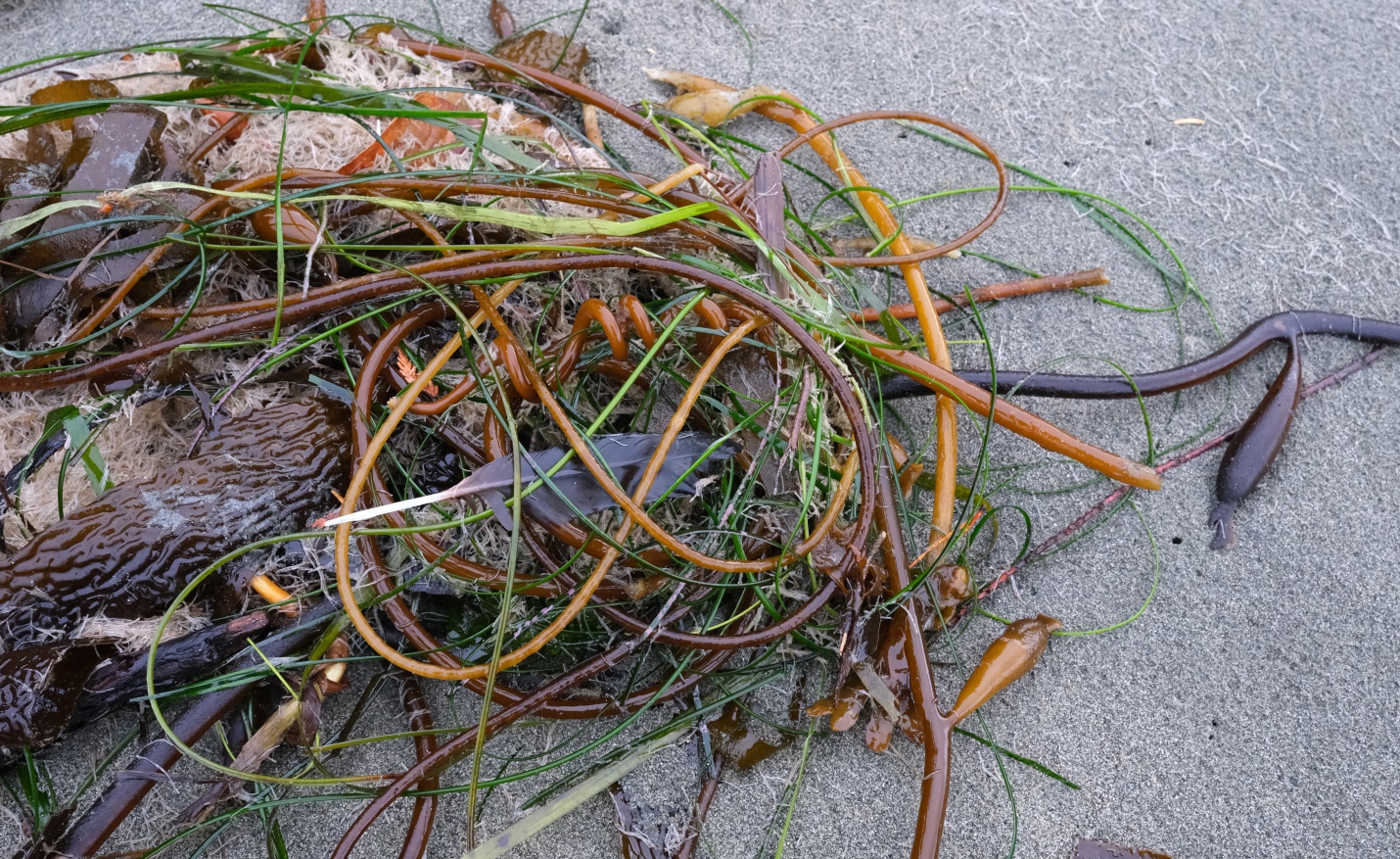
Figure 1: A tangle of seaweed and seagrass, plus tube worm casings and even one bird feather, is pictured here as it was deposited by the receding tide. If you look closely at some of the green seagrass stems you will possibly see some sections of ‘pink’ – this is the coralline algae Melobesia mediocris. Florencia Bay, Vancouver Island, B.C., Canada. November 25, 2022. Photo ID 27435 ©Seaweedwhisperings.com
Person 1:
I have seen this seaweed many times before, always on the narrow-bladed surfgrass, Phyllospadix scouleri. It doesn’t coat all the seagrass blades, but maybe it colonizes some special blade characteristic.
Once I was ready to have an interaction with Melobesia mediocris I immediately wanted to look very closely. It had always just appeared to me as a nondescript white to pink coating on the surfgrass blades, but today something was drawing me closer.
I used my binocular to magnify the algal blobs and was captivated, maybe even impressed, by all the small black dots looking like specks of black pepper on a background of cooked egg white.
On some of the surfgrass blades Melobesia nearly entirely coats the surface. But it’s not a single algal organism, but a series of individuals. Each has its own shape, then independently grows until it bumps into another.
Oh, I can’t recall what they do when they touch each other..., so I looked at a photograph I’d recently taken. Rather than growing onto or over, they seem to push against each other along the surfgrass blade, then some crack and break apart where they meet. I guess they are a bunch of independent beings that reluctantly live in close proximity to each other. If boundaries are transgressed the docile Melobesia becomes irritated and feisty – but under stress may easily break apart. Their willingness to fight is not all bluster, but it often costs them highly.
In coloration and shape Melobesia mediocris is more gentle and prettier than the Melobesia marginata we’ve seen on some species of red seaweeds. The gentleness conveyed by the soft pink strikes me as the antithesis to potential aggressiveness mentioned above. Perhaps M. mediocris simply likes to “live in its own world”, in dreamland, and is only occasionally forced into battle to preserve its territory.
Thinking about the “black pepper dots” which actually are holes, I wonder if they are associated with reproductive structures.
Figuratively, perhaps they are tiny windows into life beyond “dreamland”.
In dreamland Melobesia mediocris is oblivious to the impact it might have on its host, likely adding lots of weight and drag which will hasten the surfgrass breaking away from the substrate. That will also hasten the demise of the current generation of Melobesia. But Melobesia doesn’t care.
Seagrass crust is NOT irritating or bugging others like one other small seaweed (Microcladia borealis) I recall interacting with. This relates to the aspect that this seaweed doesn’t seek attention.
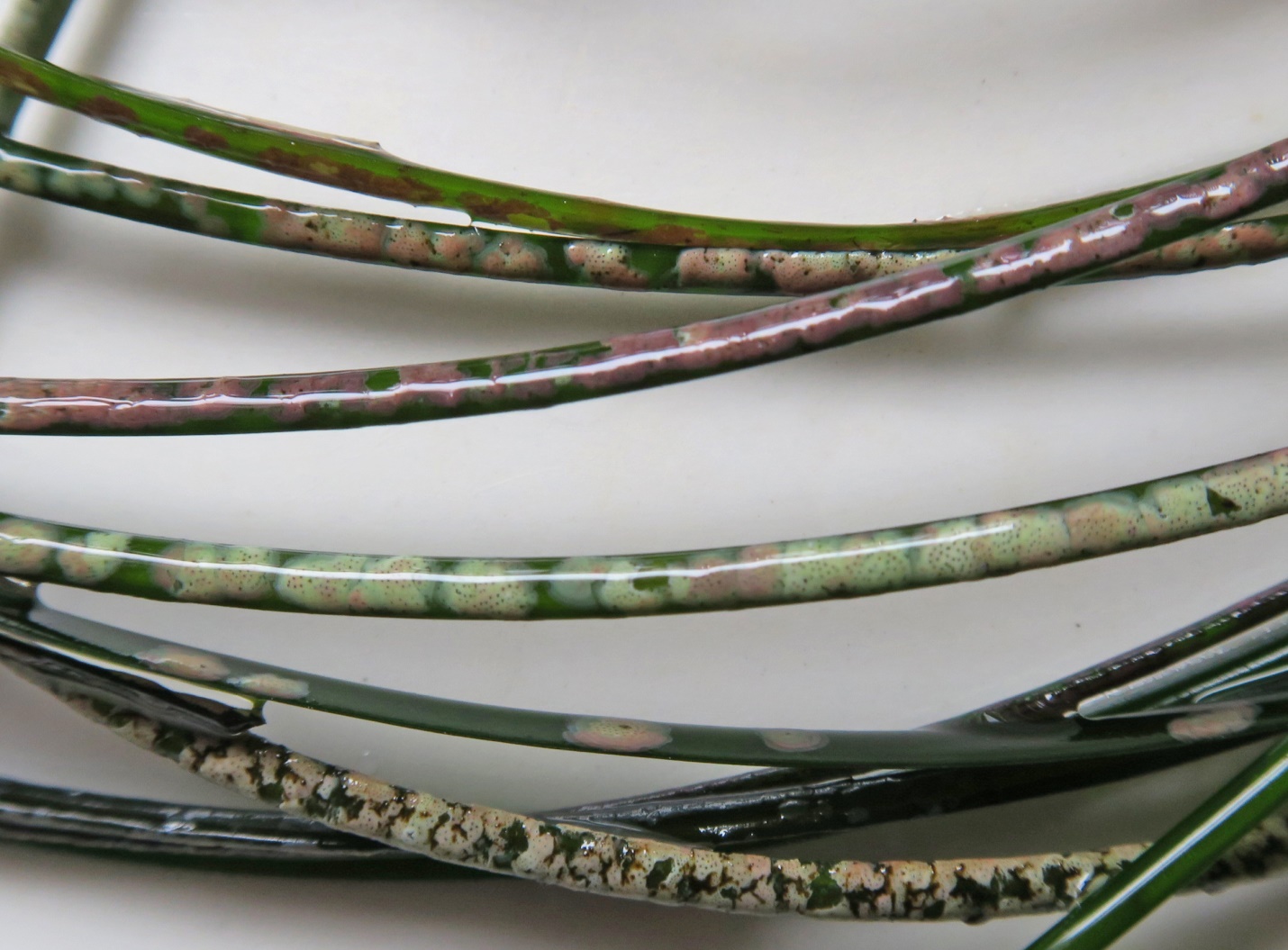
Figure 2: A much enlarged view (4 to 5 times life size) gives definition to various “crusts” of Melobesia marginata. The black dots or ‘holes’ are openings to male and female conceptacles. A healthy coralline alga is pinkish in color, so we surmise that the whitish crusts may be diseased, sun bleached or dying. Chesterman Beach & Long Beach, Vancouver Island, B.C., Canada. November 24, 2022. Photo ID 27436 ©Seaweedwhisperings.com
Person 2:
Wandering the beaches in daylight hours between the low tides there are countless clusters and tangles and jumbled masses of seaweeds left high in the drift. Lower down the beach and closer to the water’s edge the tangles are more newly deposited and contain many long thin strands of rich green surfgrass. Here in the shoreline ecosystem of Pacific Rim there are long sand beaches that are exposed to the open ocean and they are framed between impenetrably rough rocky headlands; on the extreme low intertidal and upper subtidal bedrock Phyllospadix scouleri, Scouler’s surfgrass, finds the perfect home and grows prolifically.
Recent night time low tides and high winds have impacted that very low intertidal and high subtidal zone, tearing away algae and seagrasses and bivalves alike. The surfgrass has been washed ashore mainly with Macrocystis pyrifera and sometimes Egregia menziesii, too; these brown kelps themselves are several meters in length so there is much possibility to enmesh with the long strands of surfgrass in quite a curved and complicated biomass knot.
Gradually, as I walked several kilometers on these shorelines I came to understand that “the” seaweed of note in this time and place was a tiny one, one that doesn’t wash ashore on its own, but one that grows firmly adhered to the surfaces of many of the countless strands of seagrass I’ve been observing – that is Melobesia mediocris.
I found it interesting that at first I didn’t really “notice” the pink or pinkish white or pinky mauve spots of this tiny algae. In overall presence it probably is far more numerous than the massive seaweeds it washed ashore with, but it is so small and so paired up with the surfgrass that it is mainly inappreciable. So first I had to ‘notice’ this seaweed, and once that had happened I initially thought, “No, I’m not that interested in you, Melobesia”, and “I’m really not ‘hearing’ much from you”. Then, I gathered some strands of the surfgrass that were particularly populated with countless bits of Melobesia. As I walked down the beach with them in hand, gradually my perceptions opened to this tiny and rather unusual seaweed. It was as if I needed to bring it in closer so I could “hear”, above the sound of the incessantly crashing surf, the occasional and quiet murmurings of Melobesia mediocris. And even my vision, when I looked at the patches of Seagrass crust as closely as my eyes would focus, my visual perception seemed inadequate, too. I felt that I would like a magnifying glass, or even a microscope, because I sensed there might be more to “see”.
So..., bring in close – to hear.
Bring in close – to see.
I brought out my 20X hand lens to enhance my vision. I now can see that the pinkish “crusts” are quite raised from the smooth surface of the seagrass, and the crust seems to be comprised of many tiny circular parts. Every so often a circle’s space is vacant, creating a tiny dark opening. Looked at super up-close this crust is reminiscent of a pink taffy candy that is bubbling and cooking as it thickens. Do the dark air holes lead to ‘treats’ of some kind?
But I think with Melobesia it’s an entirely different story. There is no single homogeneous mixture of pink liquid that is splashed on the seagrass blades, instead it looks like it is a proliferation of small but distinct individuals or circular “ones”. One circular pink dot of algae here, one there, one more over here, and so on and so on along the surfgrass host. The ‘holes’ or black ‘vacancies’ seem to be where no “one” has taken up residence yet.
And I wonder about that aspect, too, Melobesia. How on earth, or I should say, “how on sea” did you come to find this particular “residence”? How did you find that the best place to make your home was by affixing yourself to the blades of seagrasses?
Are you so tiny that everywhere else that you made attempts to settle you were quickly out competed? Indeed, does that still happen and it is undetectable?
Or did your great, great, great ancestors simply try out the seagrass ‘lodgings’ and find them to be quite satisfactory, indeed? So..., you remained.
Certainly given your diminutive size, choosing seagrasses for a home gave you lots of potential home sites to settle.
And then did you also discover the benefits, and possibly even the fun, of your chosen host? Benefits include that the seagrass is always in motion; it swishes and sways in the ocean currents thereby ‘moving you’ to fresh sources of nourishment and sunlight without you needing to move one teeniest bit. Fun just might include the ‘ride’ you enjoy as the seagrass moves with the ocean currents and swells. Once settled on your seagrass home you don’t seem to have to “do” much at all, Melobesia – very clever.
This association seems to be quite grand for you, Melobesia, until such time as the big fall and winter storms arrive, especially the ones that arrive simultaneous with the winter solstice low tide cycles. This would be when your surfgrass host is most vulnerable to being torn away from its bedrock moorings. Then, well, then your fates are merged and one and the same.
“Merged” and “one and the same” is a quality that permeates, I think. It is how Melobesia stays unnoticed; it doesn’t stretch out from the grass but covers it with a crust that looks ‘merged’ and as if it is a ‘part of’ the seagrass. The same goes with your ecosystem needs and your photosynthesizing natures / requirements.
But, Phyllospadix scouleri is a surfgrass.
You, Melobesia, are algae.
The surfgrass is vivid green.
You are pinkish in color.
The grass is smooth; you are somewhat bumpy.
Melobesia “mediocris”, perhaps it is a “mediocre” job you do of being the “same and merged”.
But that is only discernable if you are observed “up close” and at the scale of your own tiny dimensions. From any distance at all you do look “merged” and “as if one” with the seagrass.
When I paused a bit, and then reviewed some of the photographs of various stems of seagrass we’d been interacting with, it was apparent that up close the “look” of Melobesia has a striking amount of variety. The collections of “pink coralline alga” that make up the crust make for many random and differing looking arrangements. There seems to be a pattern to the basic growth of the individual, but how they group up, when viewed closely, is not ordered much at all. In fact it looks almost “accidental” or certainly not selected with much forethought. Perhaps young Melobesia have to choose their place to settle in a bit of a hurry or at a point in their life cycle when there’s no real thought for the future. This is a bit surprising and only discernable when you look up close.
As I sat longer pondering the look of the Melobesia crusts, I shifted my perspective to the surfgrass. I don’t think the surfgrass suffers unduly with small colonies of Seagrass crust, but it does ‘spoil’ the sleek green look to Phyllospadix. The Melobesia crusts loosely remind me of various blemishes to human skin, like rashes or scabs or eruptive reactions. But a rash arises from within; it is a reaction of the ‘animal’ response from within. Melobesia is a ‘crust’ that sits atop its host.
Yes, Molebesia and seagrass is a “TWOSOME”.
The crust is not arising as a pathological reaction from within the seagrass, it is partnering with the seagrass.
This makes me wonder just what mechanism Melobesia uses to affix to its seagrass host. The seagrasses in general, and especially Scouler’s surfgrass, have a very smooth and slippery looking surface. Does Melobesia anchor itself with some kind of suction? Or does it use some kind of tiny, penetrating holdfast growths?
I tried to scrape the “crust” off of a blade of surfgrass with my fingernail. It scraped off quite easily and crumbled into tiny pieces of grit that are colored exactly the same as they were on the surfgrass. The grit is far finer than grains of sand or salt yet it is gritty even so.
Again, I’m thinking about size, and relative sizes.
To put things in perspective, the surfgrass blades we had found were strong, smooth, long (up to 2 meters), somewhat solid feeling as the grass is thicker in the middle than at the margins, and it is only 2 mm or 2.25 mm in width. On these blades of surfgrass I see what look to be ‘groupings’ of slightly raised circular Melobesia components that encircle one tiny black hole or vacancy. If you consider each of these clusters or groups to be ‘a unit’, there are easily ten or twelve of them that fit on the surfgrass width of only two millimeters. Another more colloquial way of describing this is that I think you could easily fit six or eight groupings on the head of pin – that is how tiny this alga is!
I do not know the structure that defines “one” Melobesia algae and this is somewhat confusing to me. I cannot tell if each tiny dot in the ‘groupings’ is one algae, or if the cluster of circular parts including the ‘hole’ is one algae, or if it is some other arrangement I cannot decipher. Whatever the base unit is, however, the groupings do eventually encroach upon each other – after all there’s not that much space on the surfgrass blade! It appears as if they nudge up to each other and possibly even layer atop each other. When abundant, the growths amalgamate and look like a single chalky pink coating or crust. But somehow, even without the use of a magnifying instrument, the idea that the crust is ‘comprised of’ circles comes through.
And these circles are ‘flattened’, they are definitely not spheres; maybe the constant movement of the surfgrass blades against each other really discourages and limits vertical growth. So, the direction for growth for Melobesia is mainly horizontal and therefore only very moderately thick. But thickness IS relative, and even with such a tiny seaweed as this, if you run your hand over the collections of Seagrass Crust on the surfgrass blade it is a bumpy experience. The feel is of a series of small, hard, bumps of varied dimensions. The feel is hard, and if the algae dries out, chalky; it is almost like a mineral.
Tiny size.
Hard like a stone or mineral.
Let’s the host do the work for it (moving in water to access nutrients).
Doesn’t do much, or so it seems.
Or, maybe it does quite enough, thank you very much!..., but it does so at a pace more like a stone – its progress or pace of action is one that is slow. Compared to some kelp species that might grow 15 centimeters in length in a single day, this seaweed is like a fossilized sloth!
And of course, perhaps slow is very appropriate, otherwise they would outgrow their home, and for Melobesia mediocris that would be very undesirable, actually it feels like that would be one of the scariest predicaments they could face.
So, slow is good! Slow prevents errors and loss. Slow is just right.
We know of another Melobesia species, Melobesia marginata, and with this one, the species name of “mediocris” brings to mind another feature of this algae.
Mediocre, common, common place – it seems that there are many ‘things’ that fall into the category of being ‘common’ that are also very useful, even essential actually, but these same things are also often not highly valued.
For Melobesia mediocris it feels like they value NOT standing out, indeed that could be harmful to them, and it seems that their value or worth is one that is most comfortably left undiscussed, not publicly proclaimed whatsoever. I think there is a high chance that Melobesia mediocris would be quite easily inaccurately “measured” and this has taught them to remain mainly out of sight..., busily contributing in their way and with their style of good efforts, but also hidden away from outside evaluation. Unfair or cursory judgements can be deeply upsetting and it feels like the little pink packages of algae could at times fail to contain their frustration, anger and disappointment. These feelings are ones that take up much space, and therefore are ones they’d rather keep unnoticed, and even better, avoided.
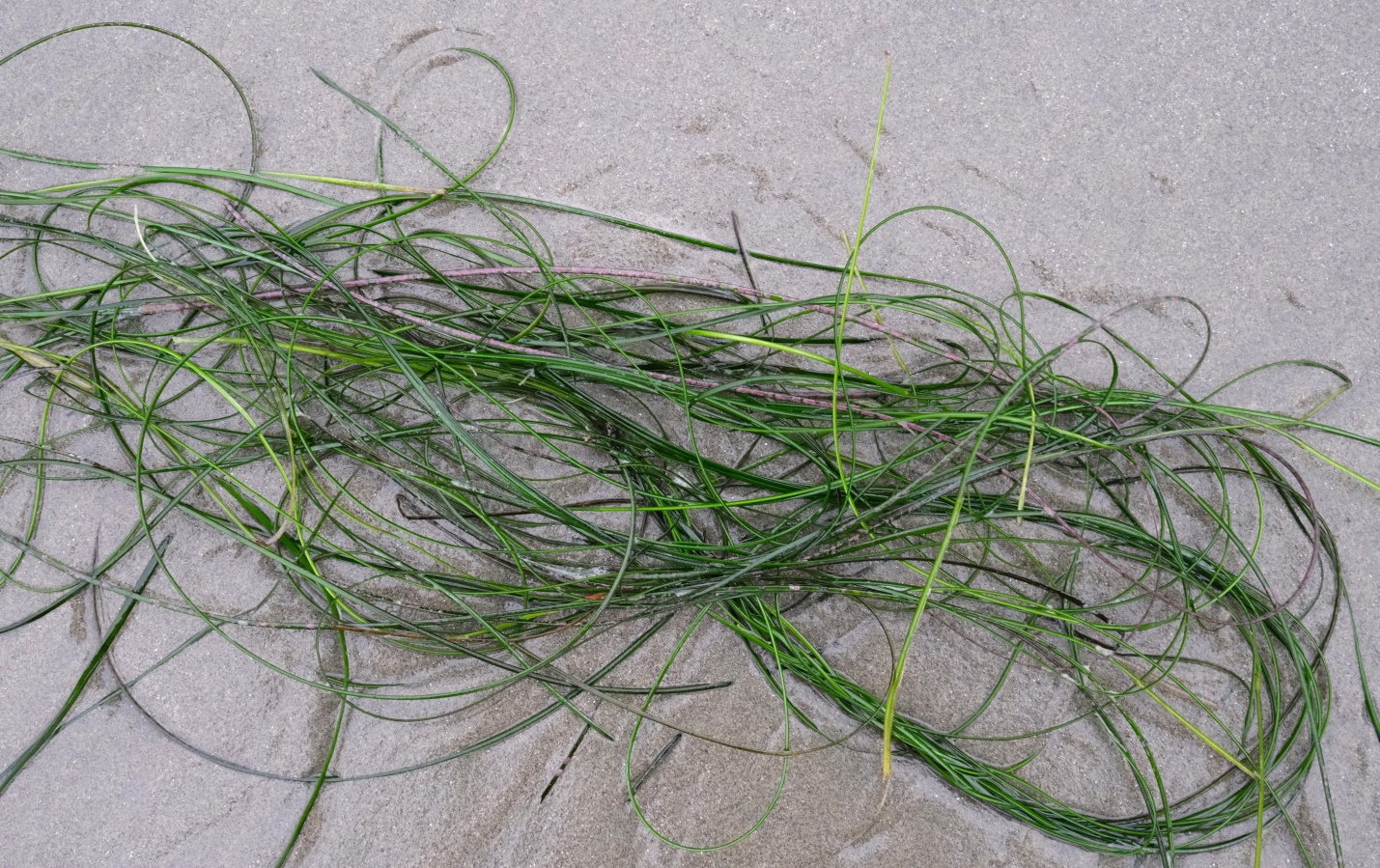
Figure 3: A collection of Scouler’s surfgrass has washed ashore here with no other organisms. While it lies on a sandy beach, immediately adjacent are rocky headlands and offshore rock islets – these are the perfect home for this seagrass species. Crusts of pink Seagrass Crust are living on many of these surfgrass leaves. They can easily be overlooked unless you take a closer look. Chesterman Beach, Vancouver Island, B.C., Canada. November 24, 2022. Photo ID 27437 ©Seaweedwhisperings.com
Discussion:
So tiny it’s inscrutable. So quiet or only seldom speaking it’s not much heard.
Spent time trying to “see” it / “hear” it.
Slow moving, takes their time..., slow and steady is their nature.
Maybe “vacancies” are useful to Melobesia. Vacancies can be spaces of time..., areas of nothing..., that are well employed or simply enjoyed.
Comprised of circles..., for an organism of tiny dimensions this maybe allows a type of ‘action’, one that is circling back or circling round. And if circles are progress, when measured on a linear scale the action of Melobesia would seem to be very slow, almost indecipherable.
Can Melobesia themselves get “lost” in circular thinking at times? How does one mark their place or progress on a circle route?
To have skills in circular ‘motion’ may be quite a distinct and perhaps unusual trait.
Mediocre, yes, this can be “common” and it is also stable. They have stability; they’re slow and steady, and NOT flashy. Perhaps Melobesia mediocris is a counterpoint to those who are flashy or speedy or forceful.
Contemplative. Ideas flow if there is no pressure, especially time pressure.
On their own is best – this gives time to develop thoughts and plans. Prefer to be on their own doing things their way and at their pace.
Don’t like being asked for or singled out to give an opinion, don’t like to be obliged to give a response.
Incapable (mainly?) of casual and light responses; if they respond they want to give a deeper more measured one. For Melobesia this deeper response comes, but it takes time to formulate, and by then often the topic has changed and others have moved on ahead of them.
Confused / confusing..., wanted to understand what the ‘base unit’ was comprised of but couldn’t manage to do so. This engages one for a time, especially if one likes enigmas or puzzles, and then ultimately leaves one to conclude that Seagrass crust is not really “knowable”. Melobesia’s energy can be very much like that..., an outsider will find much that they cannot quite comprehend, or that is somehow inaccessible, imperceptible, not well-defined nor well-expressed and this can be confusing. Melobesia truly can be inscrutable, very difficult to know and understand “up close” and in relationships this can present very real limitations.
Does Melobesia prefer this? No, it seems to simply be a consequence of differing capacities.
How then does Melobesia mediocris handle these relationship stresses or gaps? It seems that here they lack feistiness and will often retreat inwards. They will adapt and most often choose to “go along to get along”.
Person 1 stated that Melobesia “doesn’t care” about the impact of its presence on the surfgrass..., “doesn’t care” in the sense that they don’t even think about it. And, yes, objectively viewed this lack of care may hasten the completion of the cycle of life, for BOTH species of this twosome, but this is not contemplated or considered. It just doesn’t factor in to the Melobesia mediocris reality, or so it seems. The reality that DOES factor in largely is to HAVE that twosome, that all so necessary and very specific home settling place.
We found with this seaweed interaction both of our writings were much more on the prosaic side than usual, and, relatively speaking, very well written.
Person 1 said, at an early reading of his notes, “My writing is more like prose, it’s like telling a story”.
Person 2 found that she couldn’t transcribe her field notes quickly for this seaweed; she felt obliged to take time going through and transcribing them thoroughly and slowly. This matched the energy of Melobesia and needed to be honored.
What we also found to happen with the “slow and methodical” theme was that it obviously slows things down; this can put the listener “to sleep”, this can lead to reactions something like, “ah, I’m not interested in this”. Again, Melobesia could be found to be not interesting to others. On the other hand, they’d be a great type to read bedtime stories to children.
It is humorous to note that Melobesia mediocris is an obligate epiphyte on seagrasses, and seagrasses are marine plants that form extensive “beds” on the shorelines of the world. Perhaps there is an association here with Seagrass Crust and beds.
Slow and methodical, slow in their speech, deliberate in their actions – taking this one step further could lead to the appearance of being a little “spaced out”, as in they don’t seem to be all “there”. And this may be so because the Melobesia action is inside – they’re contemplating, they’re formulating, they’re processing and they’re not yet ready to be expressing. Gradually they form their opinions and make their conclusions, possibly after circling around the concept for many rounds. The activity of their contemplation seems to separate them, as if they are detached from the action around them in a notable way.
Dreamland, this concept was noted early on and we explored just what IS “dreamland” for Melobesia...? It is perhaps this contemplative state. Maybe it is only to the outsider that it seems they are in dreamland when actually they are engaged in slower contemplation; they are preoccupied with their own introspection and involved with their explorations, and this same process is at work for everyday or more mundane decisions and issues as well. Others will have long since decided what to make for dinner, or where they’d like to go for their weekend get-away by the time Melobesia speaks their preferences. Once more, this can lead to the confusion ‘issue’ arising, as answers come out of sync with the rate that others are moving. It would be good for others to “slow down” a bit, back up even, and see what Melobesia has to say; many times they don’t say a lot, but they often make up in quality what is lost in quantity or speed.
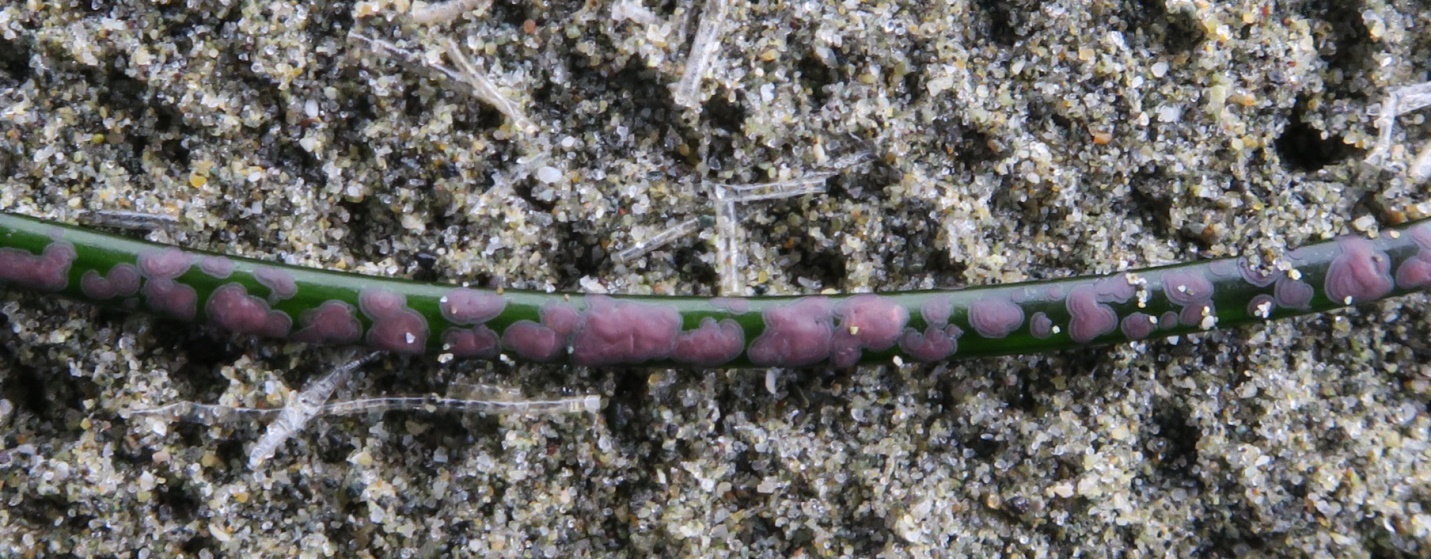
Figure 4: A single blade of surfgrass is shown here with many pink ‘circles’ of Melobesia mediocris growing on it. This photograph (depending on your screen size) is magnified at least 4 to 6 times larger than life. The grains of sand on the beach are pock-marked by rain and the small transparent ‘tubes’ are the casings from Cellophane Tube Worm, Spiochaetopterus costarum. This worm lives on the sandy bottom of the ocean just lower than the tide line. The same heavy surfs that have detached the surfgrasses from their homes have dislodged the Tube Worm casings as well. Florencia Bay, Vancouver Island, B.C., Canada. November 25, 2022. Photo ID 27438 ©Seaweedwhisperings.com
Biology & Natural History Information:
Description:
A pinkish, coralline crust that grows only as an epiphyte on seagrasses. When solitary Seagrass Crust forms thin circular patches that can grow to between 2 to 5 mm in diameter; patches often cluster up and become irregular in shape as they enlarge and push against each other, ultimately coalescing into a dense crust or coating. This minutely sized alga has small holes in the surface; they lead to male and female conceptacles.
Habitat:
On blades of Phyllospadix spp. and Zostera marina only, in the low intertidal and upper subtidal regions.
Pacific Coast Distribution:
Haida Gwaii, British Columbia to Baja California, Mexico.
Remarks:
‘Melobesia’ is from the Greek, for the daughter of Oceanus. A closely related species, Melobesia marginata, has the same distribution but grows epiphytically on non-calcareous red algae including Osmundae, Ahnfeltia and Rhodymenia.
Classification:
Phylum: Rhodophyta
Class: Florideophyceae
Order: Corallinales
Family: Haplidiaceae
Genus: Melobesia
Species: Melobesia mediocris (Foslie) Setchell & L.R.Mason 1943
Former name(s):
Lithophyllum zostericola f. mediocre Foslie 1900, Melobesia zostericola var. mediocris (Foslie) Setchell & N.L.Gardner 1903
As an obligate epiphyte on seagrasses, no discussion of the biology of Melobesia mediocris would be complete without a brief look at the Seagrasses themselves.
Seagrasses – Phylum Magnoliophyta:
There are 48 species of seagrasses in the Phylum Magnoliophyta worldwide. While they are not true grasses, they are true seed-producing flowering plants and are generally thought to be more closely related to lilies than their namesake. Seagrasses have adapted to the marine environment and are considered to be ecologically highly valuable – they provide high caloric, protein-rich food for grazers, and the dense beds they create are habitat for a varied group of invertebrates, seaweeds, forage fish, and birds including waterfowl and shorebirds.
Seagrasses grow very quickly during spring and summer and then may wash up in large amounts following storms or annual dieback later in the season. Their basic structure includes rhizomes which produce roots at their nodes and long, very slender, ribbon like leaves. The leaves branch alternately in two rows down the stem. Flowers are inconspicuous and are grouped into spike-like structures near the base of the leaf clusters or, in some species, are arranged along elongated shoots.
Seagrasses have adapted several specialized traits for success in their marine environment. They have complex root systems, and their leaves are both flexible and also contain air spaces for floatation; both of these features enable the seagrasses to manage changing water levels and wave energies well. The stomata (holes) that allow passage of gasses that are normally found in vascular plants are lacking in seagrasses entirely. And instead of having chloroplasts located in internal tissues or the mesophyll (as most land plants have), the chloroplasts of seagrasses are closer to the leaf surface in the epidermis. This permits higher photosynthetic functioning when the ‘grasses’ are submerged. And reproductively, the grasses will produce pollen in gelatinous strands in a variety of shapes – thread-like, spherical and boomerang-shaped to name a few; these forms are highly successful at being carried by water currents to the female flowers. Hooks on the fertilized fruit / seed combination are designed to ‘catch’ on particular seaweed morphologies and once snared, the young seagrass plants send down roots to secure the plants to the substrate.
In our coastal waters there are two main types of seagrasses. Eelgrass, Zostera marina, which inhabits regions of protected, soft sediment (mud, sand or gravel). Surfgrasses are by contrast inhabitants of exposed rocky beaches. The two common species in this grouping are Phyllospadix serrulatus and Phyllospadix scouleri.
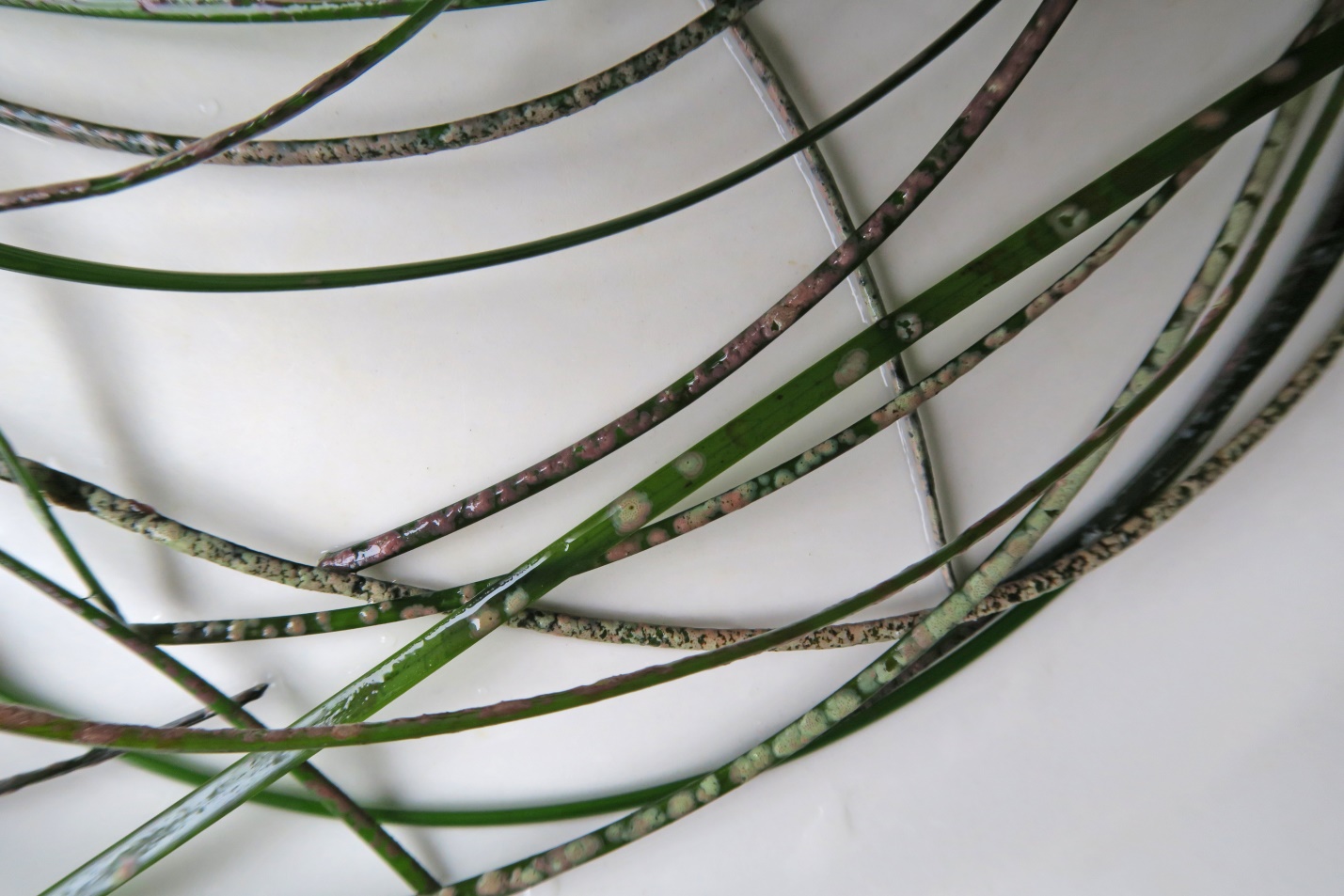
Figure 5: Another view of the “twosome” of surfgrass and Seagrass Crust. Long Beach and Chesterman Beach, Vancouver Island, B.C., Canada. November 24, 2022. Photo ID 27439 ©Seaweedwhisperings.com
![]()